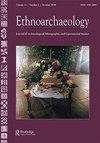Rituals of the Past: Prehispanic and Colonial Case Studies in Andean Archaeology
IF 1.3
0 ARCHAEOLOGY
引用次数: 2
Abstract
similarly organized, making cross-cultural comparisons relatively easy, limited only by the quality of the original data (for which these authors are not to be faulted). Some of the most significant insights from these cases include examples where yarn quality estimates derived from spindle whorl weight do not match well with suggested tensions estimated from preserved loom weights, thus supporting conclusions that loom alternatives to the warp weighted loom existed, for example the horizontal ground or two-beam upright loom for which we have no preserved archaeological examples; and instances where estimates of thread types based on excavated loom weights supports the existence of multiple looms. The final chapter summarizes the volume and offers some concluding remarks about broader areas to which an understanding of textile tools can speak: for example, labor hours, workshops, gender, labor mobility and seasonality. Editorially, this is a nicely formatted volume with a map of the sites included in the database and a chronological table by region for the eastern Mediterranean Bronze Age that also incorporates formal and descriptive terms, both of which are used in the case studies, and additional reference markers such as “advent of sailing” and “Thera eruption,” which assist in recognizing a few pivotal historical moments in textile technology. Two appendices contain records of textile remains in the Eastern Mediterranean, organized both regionally and chronologically. My only critique is that all the remains are discussed as a single site record, so it is not always clear as to which fragment the data describes. Finally, many of the authors call for publication standards for textile tool descriptions, preserved textile remains and reporting guidelines for textile experimental archaeology, the need for which is clearly seen in the case studies presented here and something that the TTTC database and this volume should go a long way towards rectifying.过去的仪式:安第斯考古中的前西班牙和殖民案例研究
类似的组织,使得跨文化比较相对容易,只受限于原始数据的质量(这些作者没有过错)。从这些案例中获得的一些最重要的见解包括,从主轴轮轴重量得出的纱线质量估计与从保存的织机重量估计的张力不太匹配,从而支持存在经纱加权织机替代品的结论,例如我们没有保存的考古样本的水平地面或两梁直立织机;在一些情况下,根据挖掘出的织机重量来估计螺纹类型支持多台织机的存在。最后一章总结了本卷,并提供了一些关于纺织工具的理解可以说话的更广泛领域的结论性评论:例如,劳动时间,车间,性别,劳动力流动性和季节性。编辑方面,这是一本格式精美的书,包含数据库中的遗址地图和地中海东部青铜器时代的地区年表,其中还包含了案例研究中使用的正式和描述性术语,以及额外的参考标记,如“航海的出现”和“锡拉火山爆发”,这有助于认识纺织技术的几个关键历史时刻。两个附录包含东地中海地区纺织品遗迹的记录,按地区和时间顺序组织。我唯一的批评是,所有的遗骸都是作为一个单一的站点记录来讨论的,所以并不总是清楚地知道数据描述的是哪个片段。最后,许多作者呼吁为纺织工具描述、保存的纺织品遗骸和纺织实验考古报告指南制定出版标准,这在这里介绍的案例研究中可以清楚地看到,TTTC数据库和本卷应该在很大程度上加以纠正。
本文章由计算机程序翻译,如有差异,请以英文原文为准。
求助全文
约1分钟内获得全文
求助全文
来源期刊

Ethnoarchaeology
ARCHAEOLOGY-
CiteScore
1.60
自引率
0.00%
发文量
10
期刊介绍:
Ethnoarchaeology, a cross-cultural peer-reviewed journal, focuses on the present position, impact of, and future prospects of ethnoarchaeological and experimental studies approaches to anthropological research. The primary goal of this journal is to provide practitioners with an intellectual platform to showcase and appraise current research and theoretical and methodological directions for the 21st century. Although there has been an exponential increase in ethnoarchaeological and experimental research in the past thirty years, there is little that unifies or defines our subdiscipline. Ethnoarchaeology addresses this need, exploring what distinguishes ethnoarchaeological and experimental approaches, what methods connect practitioners, and what unique suite of research attributes we contribute to the better understanding of the human condition. In addition to research articles, the journal publishes book and other media reviews, periodic theme issues, and position statements by noted scholars.
 求助内容:
求助内容: 应助结果提醒方式:
应助结果提醒方式:


